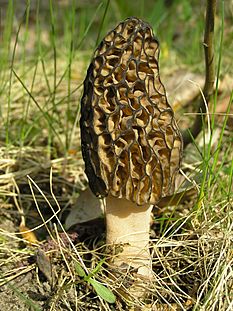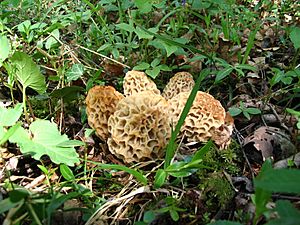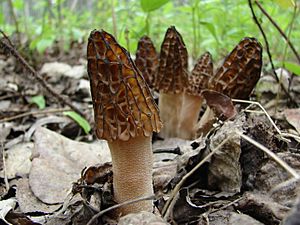Morel facts for kids
Quick facts for kids Morel |
|
|---|---|
 |
|
| Morchella conica, a black morel, in Poland | |
| Scientific classification | |
| Kingdom: | |
| Division: | |
| Subdivisio: |
Pezizomycotina
|
| Class: |
Pezizomycetes
|
| Order: |
Pezizales
|
| Family: |
Morchellaceae
|
| Genus: |
Morchella
Dill. ex Pers. (1794)
|
| Type species | |
| Morchella esculenta (L.) Pers. (1801)
|
|
Morels are a special type of edible mushroom. They belong to a group of fungi called Morchella. These mushrooms are famous for their unique look. They have a cap that looks like a honeycomb, with many ridges and pits. Morels are closely related to other mushrooms known as cup fungi.
Contents
Why Morels Are So Special

Morels are very popular in cooking around the world. Chefs love their amazing flavor. They use morels in many different dishes. Just like most edible mushrooms, morels taste best when they are fresh.
A simple way to enjoy morels is to cook them gently in butter. You can add a little salt and pepper. Morels are great in meat and chicken dishes. They also taste good in soups or as pasta fillings.
Remember, you must always cook morels before eating them. This is because raw morels contain natural substances that are not good for you. Cooking destroys these substances, making the mushrooms safe to eat.
How to Store Morels

You can store morels in a few different ways. One way is to freeze them. First, quickly rinse them under cold water. Then, spread them on a baking tray and put them in a freezer. Once frozen, you can keep them in airtight containers.
Sometimes, frozen morels can become a bit soft when they thaw. To avoid this, it's best to steam or fry them before freezing.
Morels can have small bits of soil inside their honeycomb-like caps. You can cut the mushroom in half lengthwise to check. Use a brush to gently remove any visible soil. Some people like to soak morels in salt water before cooking. However, many chefs prefer not to do this.
Drying is another popular way to store morels for a long time. You can often buy dried morels in stores. If there are any tiny insects inside the mushrooms, they usually fall out during drying.
To use dried morels, soak them in warm water or milk for 10 to 20 minutes. The liquid you used for soaking can then be used as a flavorful broth for your cooking!
Did you know that humans aren't the only ones who enjoy morels? In Yellowstone National Park, grizzly bears also like to eat black morels!
Safety When Eating Morels
Morels should never be eaten raw. They contain natural compounds that can upset your stomach. These compounds are destroyed when the morels are cooked properly.
It's also been reported that some people might get an upset stomach if they eat cooked morels with alcohol.
When you try morels for the first time, it's a good idea to eat only a small amount. This helps you see if you have any allergic reaction. Always make sure your morels are clean and fresh. Don't eat any that look decayed.
Be careful about where your morels come from. Morels that grew in old apple orchards might have soaked up harmful substances like lead and arsenic from old insecticides. These are not safe for people to eat.
Images for kids
-
Yellow morels in West Virginia, USA
-
Longneck morel in Indiana, USA
-
Black morel in Washington (state), USA
-
Gyromitra esculenta, a false morel
See also
 In Spanish: Colmenillas o cagarrias para niños
In Spanish: Colmenillas o cagarrias para niños






